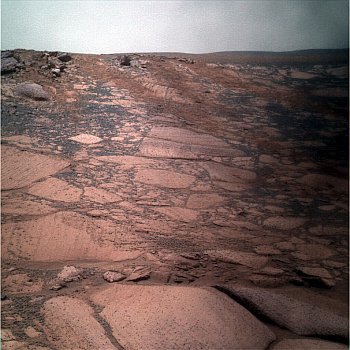
Comet Holmes at Ryerson Observatory. 36x5s exposures, 0.25m f/6.
We imaged it through our 10-inch reflector while looking at it through the six-inch refractor. I processed the images to match the visual look. This comet is so bright I was able to take reasonable images with my digital camera just pointed at the eyepiece, with a few seconds of exposure, but I can't find my memory card reader, so those will have to wait.
So--it's still naked-eye, and now obviously not a star, so get out and take a look--the lower right "star" of an isoceles triangle containing Mirfak, above the bright star Capella in the northeast. (See a finder chart here).
A lot of people were asking details about why exactly the comet increased in brightness a millionfold. Without reading further, I vaguely heard a suggestion that the heat from perihelion takes a while to move deeper into the comet to where there is still volatile ices to blow out. Right now, the comet is moving out between Mars and Jupiter.
A fantastic historical read is Fred Whipple's paper in Icarus, volume 60, issue 3: "Comet P/Holmes, 1892III: A case of duplicity?" (link may need a subscription). I quote:
It may be added that the comet was discovered as a bright object nearly 5 months earlier than its perihelion passage, although the observing geometry was favorable all the time (at perihelion, the comet should have been only 1.5 mag fainter than near opposition 5 months later). It was also the first short period comet of q > 2 ever discovered.
Barnard's 1913) description on November 9.2 at Lick Observatory is revealing:
"'Its appearance was absolutely, different from any comet 1 have ever seen--a perfectly circular and clean cut disk of dense light, almost planetary in outline with a faint, hazy nucleus and a slight condensation some 5 seconds south following the nucleus (brightness -- Andromeda Nebula, diameter 260" at 8h0 '" P.S.T. and 286" at 9h40"').'" He observed the comet to brighten perceptibly by the next night at which time he saw an outer faint diffused envelope some 12' (800,000 km) in diameter.
Barnard's description carries great weight because he was a superb and experienced observer, having already discovered 15 comets and observed many more. His comments were generally confirmed by many other observers over thc world. Interest in the comet flared as the comet burst again to nearly naked eye brilliance on January
16, 1893, after having laded some 5-6 mag by late December and early January.
On subsequent returns P/Holmes hits remained extremely faint and inactive.
- Circular -- check
- Sudden nearly naked-eye burst -- check
- Andromeda galaxy reference -- looked at Andromeda tonight right afterwards -- check
- About 10 arcminutes in diameter -- check
Don't read anything into his comet satellite hypothesis though.
Reading further back, Bobrovnikoff wrote in 1943:
The comet was not well observed in December, 1892, and in the first part of January, 1893. On January 16, Palisa, in Vienna, found with the 27-inch refractor, instead of a diffuse comet of 10th or 12th magnitude as expected, a yellow star of 8th magnitude with an envelope of 20" in diameter. The comet increased in brightness the next day and could be seen with the naked eye. After January 18 it began to decline in brightness, and by the beginning of April it became very faint.
